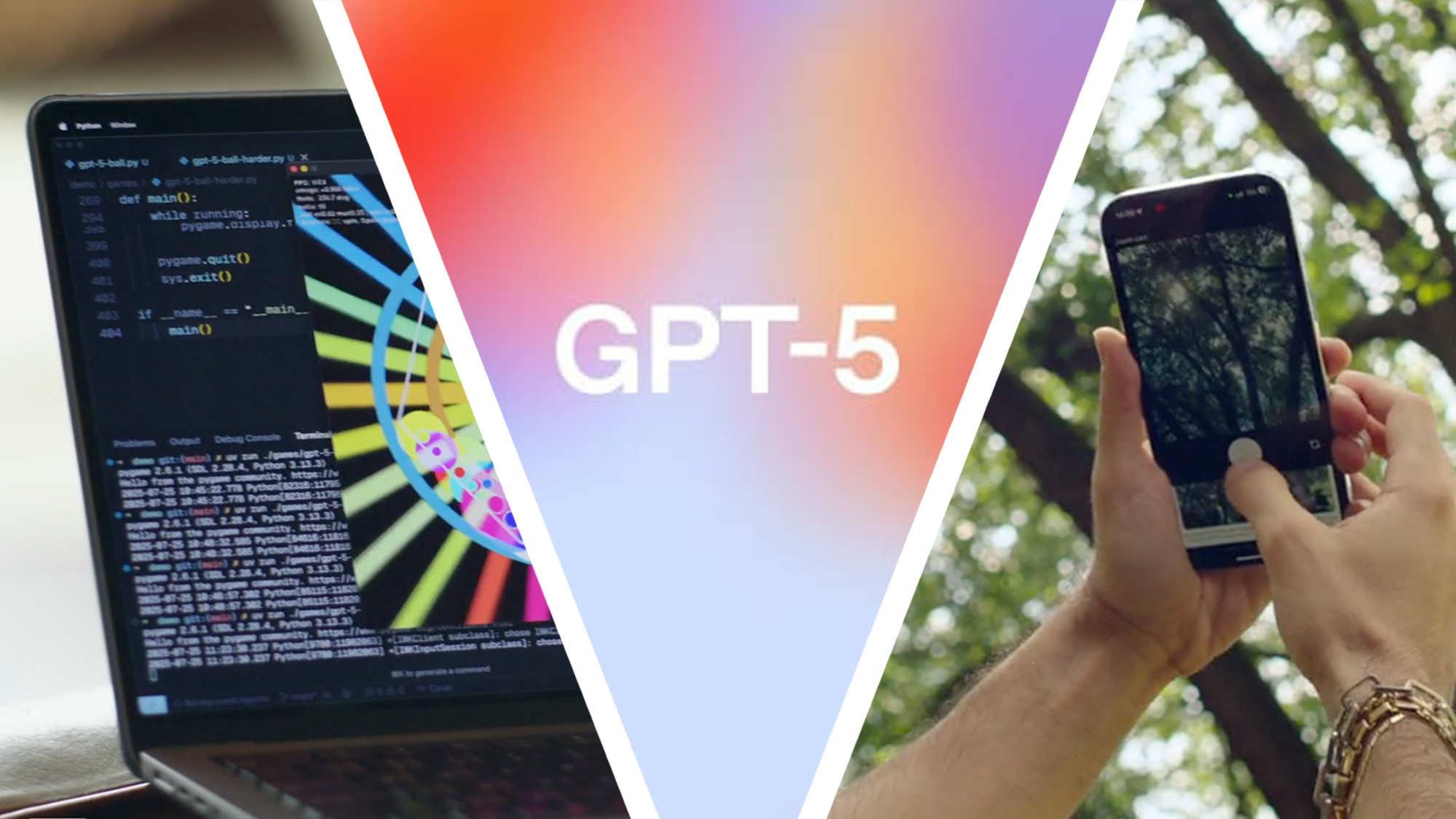I compared ChatGPT-5 Pro with ChatGPT-5 – and there's no doubt about the winner
But I don't know if you need it for your daily life

ChatGPT 5 Pro is the muscle car engine of OpenAI’s new line of GPT-5 AI models for ChatGPT. Unlike the standard versions, Pro is designed to think deeper, write longer, research harder, and generally behave like it's worth the $200 a month necessary to use it. The GPT-5 Pro model has more computational power behind it, and requires around five minutes per prompt to respond because of it.
The standard ChatGPT-5 might be plenty for most people, but I wanted to see just what a difference it could make when given complex prompts better designed for Pro. I was skeptical about whether more power would mean better answers, and decided to test the Pro model against its more pedestrian sibling. The test prompts all involve multiple complex issues; take a look at how the two models performed.
Black hole building

OpenAI has boasted of how good ChatGPT-5 Pro is at combining multiple topics and synthesizing them creatively. So, I decided to see how it did at mixing astronomy and architecture in a creative vision.
I asked both ChatGPT models to: "Explain how the physics of black holes could inspire architectural design, then imagine a futuristic building that borrows those principles."
ChatGPT-5 had a couple of paragraphs explaining black hole physics, from gravitational collapse to event horizons and singularities. It then proposed a building called the "Event Horizon Tower," describing "a cylindrical megastructure in a major city, designed to evoke both the mystery and spectacle of a black hole." Using a reflective, curved façade made of darkened glass and adaptive panels, the AI suggested light would scatter so that as you walked past, your own reflection would "stretch and curve, like time and space being tugged."
Pro took a much more narrative approach to explain the science of black holes, with shades of Werner Herzog and Neil deGrasse Tyson going through it. The building that it came up with is called the Ergosphere, which it suggested would be a public science and performing arts center set into a sunken urban plaza.
As for its black hole connection, the AI went on an evocative tour throughout the building, starting with the gravity well of "a gentle amphitheater carved as concentric steps that pull you down toward the entrance" of the "toroidal ring hovering above the plaza on a diagrid of slender struts" its outer surface a low‑reflectance ceramic-metal composite that reads as deep matte at noon and liquid at dusk."
Sign up for breaking news, reviews, opinion, top tech deals, and more.
Not only did it go into the overall design, it explained what stores would go where, the HVAC system, and how the Ergosphere would behave in culture to pull in energy from the city in one form and give more back in other ways.
Puppy playbook

I next decided to see how ChatGPT-5 Pro's reported talent for multi-form reports looked by asking to: "Create a complete starter guide for training a new puppy that combines behavioral science, practical scheduling, and real-world examples."
The standard ChatGPT-5 opened with a short intro about how training is really just structured communication, then eased into the science, walking me through the concept of operant conditioning and why puppies respond so well to consistent reward cycles.
It outlined a clear daily schedule with suggestions for what to watch for and some troubleshooting notes: “If your puppy resists the crate, start with one-minute intervals and work up. Don’t reward barking by letting them out.”
Pro wrote an entire book incorporating breed-specific traits and environmental context, then "A phased 12‑week curriculum (with daily & weekly goals)". It also had a sample daily schedule to fit it. Most notably, it addressed a lot of the current theories on how to train dogs, in a chart that included not only information on how to do things like click training and "shaping" behavior, but also cited recent scientific studies examining their value.
Oscar popularity

For the last trick, I wanted ChatGPT-5 Pro to show off its contradiction resolution abilities. I went with the always-debated issue of who deserves an Oscar by prompting the AI with: "The Academy wants to boost ratings but also honor art. Some argue for more blockbuster nominees. Others want stricter artistic standards. Write a proposal for balancing prestige with mainstream appeal."
The standard ChatGPT-5 started by acknowledging the Oscars’ history of tension between commercial hits and artistic excellence. It suggested a hybrid scoring model where box office success, streaming stats, and critical acclaim were weighted to define how good and important a movie is. As a sample of possible nominees and winners, it included Guardians of the Galaxy Vol. 3, indies including Past Lives and Aftersun, as well as actual winners like Oppenheimer and Everything, Everywhere All at Once. It even suggested a way to market the show around the broadness of the category.
Pro, as expected, went deeper in a sweeping narrative of the Oscars’ decline in viewership, citing Nielsen stats, referencing the post-Crash backlash era, and linking the Academy’s struggles to broader changes in how we define culture. It suggested keeping the Best Picture, but tuning the inputs so that a "balanced portfolio of cinema reaches the finish line: a couple of undeniable cultural juggernauts, a couple of exquisitely crafted art films, an animated triumph, an international landmark, a documentary that sticks, plus the adult‑drama and genre breakouts people debated all year." Pro also offered ways to slowly implement its plan and how to measure its success afterward.
Pro or no
ChatGPT-5 Pro offered a ton of impressive depth and complex analysis for every prompt I gave it. And these kinds of prompts are wide-ranging enough to make those responses stand out. But in all honesty, most people don't need that most of the time. The regular ChatGPT-5, with the Auto mode to adjust how the AI answers, is plenty, and the Thinking model can handle more complex requests, if not quite as well as Pro.
Not every task needs a TED Talk as an answer. And considering the price difference, I think most would agree who aren't using Pro explicitly for business purposes. People don’t want to pay more for answers that are better if they’re not also more useful. And most of the time, they’re not. For 95% of your requests, ChatGPT-5 Auto is more than enough. Unless you’re planning to design a black hole building, raise a puppy on a neurological learning curve, or overhaul the Oscars with a manifesto, that is. Then you might want to ask Pro for help.
You might also like
- OpenAI's first AI Agent is here, and Operator can make a dinner reservation and complete other tasks on the web for you
- There’s a new AI agent ready to browse the web and fill in forms without the need to touch your mouse
- I tried this new AI agent that takes control of your mouse and keyboard to help get tasks done, and I can’t believe how good it is

Eric Hal Schwartz is a freelance writer for TechRadar with more than 15 years of experience covering the intersection of the world and technology. For the last five years, he served as head writer for Voicebot.ai and was on the leading edge of reporting on generative AI and large language models. He's since become an expert on the products of generative AI models, such as OpenAI’s ChatGPT, Anthropic’s Claude, Google Gemini, and every other synthetic media tool. His experience runs the gamut of media, including print, digital, broadcast, and live events. Now, he's continuing to tell the stories people want and need to hear about the rapidly evolving AI space and its impact on their lives. Eric is based in New York City.
You must confirm your public display name before commenting
Please logout and then login again, you will then be prompted to enter your display name.